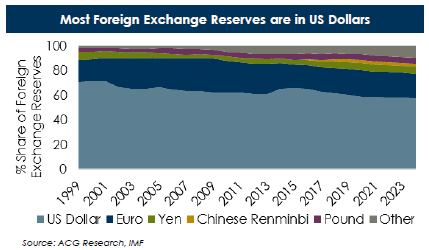Overview
- The Trump administration’s tariffs have been far broader than anticipated, causing significant market disruption
- The US dollar has weakened as the trade war has escalated, the opposite expected impact of protectionist policy
- Disrupting long-established trade relationships could have unintended side effects for the US dollar
Trump 2.0 Was Expected to Strengthen the Dollar
President Trump was elected on a platform of trade protectionism, a policy which is typically expected to strengthen the home currency. In theory, tariffs reduce the demand for foreign goods. This means fewer dollars being exchanged with other countries into the currency market, and a lower supply means a higher price – assuming demand stays constant.
While protectionism was expected, financial markets have been shocked at the breadth and magnitude of Trump’s tariff announcements, culminating in the April 2nd announcement of a 10% baseline tariff along with massive “reciprocal” tariffs for most countries. The tariffs have caused the opposite expected currency reaction, with the US dollar weakening substantially as the trade war has escalated.
One potential reason for a weaker dollar is markets are now expecting the US economy to slow materially. Relative economic strength is a key factor in currency exchange rates as goods and capital flow toward growing economies. Retaliatory tariffs also can offset currency appreciation as the counter-tariffs have the opposite currency effect. Retaliation has been somewhat limited, with the exception of China, but the expectation is for a meaningful reordering of global trade if tariffs remain, one that potentially could see less outside investment in US assets.

The US Dollar’s Central Role in Global Trade
Trump paused all reciprocal tariffs (except China) for 90 days to allow target countries to negotiate deals. Financial markets breathed a sigh of relief and the dollar briefly rebounded in response. Still, the remaining 10% tariff and other country and sector specific tariffs that remain constitute the largest tariff hike in decades. Even if tariffs eventually return to near 2024 levels or lower, it is possible the policy unpredictability demonstrated by the US will lead to permanent structural changes as countries seek more reliable trade partners.
The US dollar has been the world’s primary means of exchange since WWII, making it the most frequent currency used in international trade as well as the most commonly held reserve currency. This comes with costs as well as benefits. The cost primarily falls on US exporters, as a highly valued dollar makes exports more expensive and worsens the trade deficit. Conversely, the high demand for dollars helps the US government issue debt at a lower cost as foreign holders of US dollars invest that cash into US assets. The central role of the dollar also increases the potency of US sanctions against other nations.
Geopolitical considerations such as friction with China and Russia have already seen the dollar’s dominance come into question as countries seek to blunt the potential impact of US sanctions. But few other currencies can match the stability, economic growth, and liquid bond market that the US can offer. While the size of US dollar reserves has shrunk modestly in recent decades, it is still far and away the leading reserve currency. However, with the current trade war, the US has antagonized allies and adversaries alike. It will continue to be difficult to supplant the dollar as the leading reserve currency, but this has perhaps accelerated the trend of other currencies sharing influence with the US dollar.
Economists debate exactly what the repercussions would be of the dollar losing its reserve status, with some downplaying the issue, pointing to the similarly low rates other developed nations pay to borrow. However many economists fear it would greatly reduce the borrowing capacity of the US, along with eroding the country’s leadership position in the global financial system.

Our Position
Trump has promised additional sector specific tariffs are coming soon. Combined with ongoing negotiations with individual countries and potential retaliations, it is safe to expect more policy-based volatility in the near-term. Should negotiations fail, recent history suggests a re-escalation of the trade war would be met with more dollar weakness. Longer-term, higher trade barriers would diminish the US role in global trade and provide momentum to move away from the dollar as the global reserve currency. This would potentially raise borrowing costs for the US, putting upward pressure on bond yields. A scenario where successful negotiations result in lowered trade barriers would be a positive for global growth and likely result in near-term dollar strengthening. This scenario still potentially ends with diminished trust in the US as a trading partner and a desire to diversify global reserves, but the continued importance of the US to the global economy would likely see the US dollar maintain a dominant role. Currency fluctuations can be a key driver of relative performance across geographic exposures, and regardless of trade war outcomes a portfolio that is globally diversified will be best suited to weather market uncertainty.
Disclosures
The views expressed herein are those of Asset Consulting Group (ACG). They are subject to change at any time. These views do not necessarily reflect the opinions of any other firm. This report was prepared by ACG for you at your request. Although the information presented herein has been obtained from and is based upon sources ACG believes to be reliable, no representation or warranty, express or implied, is made as to the accuracy or completeness of that information. Accordingly, ACG does not itself endorse or guarantee, and does not itself assume liability whatsoever for, the accuracy or reliability of any third party data or the financial information contained herein.
Certain information herein constitutes forward-looking statements, which can be identified by the use of terms such as “may”, “will”, “expect”, “anticipate”, “project”, “estimate”, or any variations thereof. As a result of various uncertainties and actual events, including those discussed herein, actual results or performance of a particular investment strategy may differ materially from those reflected or contemplated in such forward-looking statements. As a result, you should not rely on such forward-looking statements in making investment decisions. ACG has no duty to update or amend such forward-looking statements.
The information presented herein is for informational purposes only and is not intended as an offer to sell or the solicitation of an offer to purchase a security.
Please be aware that there are inherent limitations to all financial models, including Monte Carlo Simulations. Monte Carlo Simulations are a tool used to analyze a range of possible outcomes and assist in making educated asset allocation decisions. Monte Carlo Simulations cannot predict the future or eliminate investment risk. The output of the Monte Carlo Simulation is based on ACG’s capital market assumptions that are derived from proprietary models based upon well-recognized financial principles and reasonable estimates about relevant future market conditions. Capital market assumptions based on other models or different estimates may yield different results. ACG expressly disclaims any responsibility for (i) the accuracy of the simulated probability distributions or the assumptions used in deriving the probability distributions, (ii) any errors or omissions in computing or disseminating the probability distributions and (iii) and any reliance on or uses to which the probability distributions are put.
The projections or other information generated by ACG regarding the likelihood of various investment outcomes are hypothetical in nature, do not reflect actual investment results and are not guarantees of future results. Judgments and approximations are a necessary and integral part of constructing projected returns. Any estimate of what could have been an investment strategy’s performance is likely to differ from what the strategy would actually have yielded had it been in existence during the relevant period. The source and use of data and the arithmetic operations used for calculating projected returns may be incorrect, inappropriate, flawed or otherwise deficient.
Past performance is not indicative of future results. Given the inherent volatility of the securities markets, you should not assume that your investments will experience returns comparable to those shown in the analysis contained in this report. For example, market and economic conditions may change in the future producing materially different results than those shown included in the analysis contained in this report. Any comparison to an index is for comparative purposes only. An investment cannot be made directly into an index. Indices are unmanaged and do not reflect the deduction of advisory fees.
This report is distributed with the understanding that it is not rendering accounting, legal or tax advice. Please consult your legal or tax advisor concerning such matters. No assurance can be given that the investment objectives described herein will be achieved and investment results may vary substantially on a quarterly, annual or other periodic basis. There is no representation or warranty as to the current accuracy of, nor liability for, decisions based on such information.
Gryphon Financial Partners shall not in any way be liable for claims and make no expressed or implied representations or warranties as to their accuracy or completeness or for statements or errors contained in or omissions from them. This was created for informational purposes only. Gryphon Financial Partners, LLC is an Investment Adviser.
